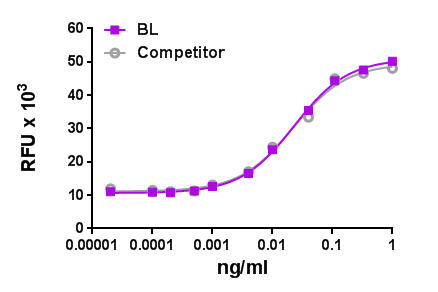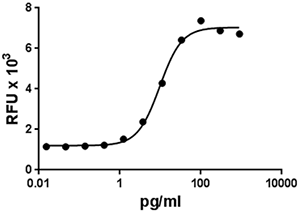- Regulatory Status
- RUO
- Other Names
- IL-36 alpha, IL-1F6, FIL1 epsilon
- Ave. Rating
- Submit a Review
- Product Citations
- publications

-

Human IL-36α induces IL-8 in A-431 human epidermoid carcinoma cells in a dose dependent manner. The ED50 = 0.4 – 2.4 ng/mL.
IL-36α is one of the IL-36 cytokines that are part of the IL-1 family. Like other IL-1 family members, IL-36α requires N-terminal processing to gain full bioactivity; currently, the proteases responsible for processing IL-36α are unknown. IL-36α signals through IL-36R/IL-1RAcP, which results in MAPK, Erk1/2, and JNK activation. IL-36α is implicated in skin homeostasis, and it is overexpressed in psoriatic lesional skin. Transgenic mice overexpressing IL-36α in skin have an inflammatory skin condition showing some characteristics of human psoriasis, including thickened scaly skin, acanthosis, hyperkeratosis, and dermis infiltration. EGF regulates the expression of IL-36α in the skin. IL-36α can also be detected in adipose tissue. IL-36α reduces adipocyte differentiation and also induces inflammatory gene expression in mature adipocytes. In lungs, the expression of IL-36α is increased in response to inflammatory stimuli. Intratracheal instillation of recombinant mouse IL-36α induces CXCL1 and CXCL2 expression and also neutrophil influx in the lungs. IL-36α, IL-36β, and IL-36γ induce in vitro expression of RNA of multiple cytokines (IL-6, IL-12 p40, CXCL1, CCL1, IL-12 p35, IL-1b, IL-19 p19, GM-CSF, CXCL10, TNFα, CCL3, VCAM-1, and ICAM-1) in mouse bone marrow-derived dendritic cells and CD4 T cells obtained from normal mice. IL-36α expression is elevated in chronic kidney disease and in rheumatoid arthritis synovium, and decreased expression correlates with a poor prognosis in hepatocellular carcinoma.
Product DetailsProduct Details
- Source
- Human IL-36α, amino acids Lys6 - Phe158 (Accession# NP_055255), was expressed in E. coli.
- Molecular Mass
- The 153 amino acid recombinant protein has a predicted molecular mass of approximately 17 kD. The DTT-reduced and non-reduced protein migrate at approximately 17 kD by SDS-PAGE. The predicted N-terminal amino acid is Lys.
- Purity
- >97%, as determined by Coomassie stained SDS-PAGE.
- Formulation
- 0.22 µm filtered protein solution is in 20 mM Hepes pH 7.2, 150 mM NaCl, 10 mM TCEP.
- Endotoxin Level
- Less than 0.01 ng per µg cytokine as determined by the LAL method.
- Concentration
- 10 and 25 µg sizes are bottled at 200 µg/mL. 100 µg size and larger sizes are lot-specific and bottled at the concentration indicated on the vial. To obtain lot-specific concentration and expiration, please enter the lot number in our Certificate of Analysis online tool.
- Storage & Handling
- Unopened vial can be stored between 2°C and 8°C for up to 2 weeks, at -20°C for up to six months, or at -70°C or colder until the expiration date. For maximum results, quick spin vial prior to opening. The protein can be aliquoted and stored at -20°C or colder. Stock solutions can also be prepared at 50 - 100 µg/mL in appropriate sterile buffer, carrier protein such as 0.2 - 1% BSA or HSA can be added when preparing the stock solution. Aliquots can be stored between 2°C and 8°C for up to one week and stored at -20°C or colder for up to 3 months. Avoid repeated freeze/thaw cycles.
- Activity
- Human IL-36α induces IL-8 in A-431 human epidermoid carcinoma cells in a dose dependent manner. The ED50 = 0.4 – 2.4 ng/mL.
- Application
-
Bioassay
- Application Notes
-
BioLegend carrier-free recombinant proteins provided in liquid format are shipped on blue-ice. Our comparison testing data indicates that when handled and stored as recommended, the liquid format has equal or better stability and shelf-life compared to commercially available lyophilized proteins after reconstitution. Our liquid proteins are verified in-house to maintain activity after shipping on blue ice and are backed by our 100% satisfaction guarantee. If you have any concerns, contact us at tech@biolegend.com.
- Product Citations
-
Antigen Details
- Distribution
-
Monocytes, T and B cells, spleen, bone marrow, tonsils, lymph nodes, skin, lung, and adipose tissue.
- Function
- IL-36α participates in inflammatory reactions, induces multiple cytokines in vivo and in vitro, and is involved in skin homeostasis and reduction of adipocyte differentiation. IL-17 and TNF induce IL-36α expression in keratinocytes and IL-22 synergizes this induction. EGF also regulates the expression of IL-36α in skin.
- Interaction
- Macrophages, adipocytes, lung fibroblasts, bone marrow dendritic cells, and T cells.
- Ligand/Receptor
- IL-36R/IL-1RAcP.
- Biology Area
- Angiogenesis, Cell Biology, Immunology, Innate Immunity, Signal Transduction
- Molecular Family
- Cytokines/Chemokines
- Antigen References
-
1. Gresnigt MS and van de Veerdonk FL. 2013. Semin. Immunol. 25:458.
2. Towne JE and Sims JE. 2012. Curr. Opin. Pharmacol. 12:486.
3. Vigne S, et al. 2011. Blood 118:5813.
4. Towne JE, et al. 2011. J. Biol. Chem. 286:42594.
5. Chustz RT, et al. 2011. J. Respir. Cell Mol. Biol. 45:145.
6. Vos JB, et al. 2005. Physiol. Genomics. 21:324.
7. Pan QZ, et al. 2013 Cancer Immunol. Immunother. 62:1675. - Gene ID
- 27179 View all products for this Gene ID
- UniProt
- View information about IL-36 alpha on UniProt.org
Related Pages & Pathways
Pages
Related FAQs
- Why choose BioLegend recombinant proteins?
-
• Each lot of product is quality-tested for bioactivity as indicated on the data sheet.
• Greater than 95% Purity or higher, tested on every lot of product.
• 100% Satisfaction Guarantee for quality performance, stability, and consistency.
• Ready-to-use liquid format saves time and reduces challenges associated with reconstitution.
• Bulk and customization available. Contact us.
• Learn more about our Recombinant Proteins. - How does the activity of your recombinant proteins compare to competitors?
-
We quality control each and every lot of recombinant protein. Not only do we check its bioactivity, but we also compare it against other commercially available recombinant proteins. We make sure each recombinant protein’s activity is at least as good as or better than the competition’s. In order to provide you with the best possible product, we ensure that our testing process is rigorous and thorough. If you’re curious and eager to make the switch to BioLegend recombinants, contact your sales representative today!
- What is the specific activity or ED50 of my recombinant protein?
-
The specific activity range of the protein is indicated on the product datasheets. Because the exact activity values on a per unit basis can largely fluctuate depending on a number of factors, including the nature of the assay, cell density, age of cells/passage number, culture media used, and end user technique, the specific activity is best defined as a range and we guarantee the specific activity of all our lots will be within the range indicated on the datasheet. Please note this only applies to recombinants labeled for use in bioassays. ELISA standard recombinant proteins are not recommended for bioassay usage as they are not tested for these applications.
- Have your recombinants been tested for stability?
-
Our testing shows that the recombinant proteins are able to withstand room temperature for a week without losing activity. In addition the recombinant proteins were also found to withstand four cycles of freeze and thaw without losing activity.
- Does specific activity of a recombinant protein vary between lots?
-
Specific activity will vary for each lot and for the type of experiment that is done to validate it, but all passed lots will have activity within the established ED50 range for the product and we guarantee that our products will have lot-to-lot consistency. Please conduct an experiment-specific validation to find the optimal ED50 for your system.
- How do you convert activity as an ED50 in ng/ml to a specific activity in Units/mg?
-
Use formula Specific activity (Units/mg) = 10^6/ ED50 (ng/mL)

 Login / Register
Login / Register 














Follow Us